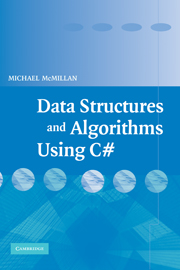Book contents
- Frontmatter
- Contents
- Preface
- Chapter 1 An Introduction to Collections, Generics, and the Timing Class
- Chapter 2 Arrays and ArrayLists
- Chapter 3 Basic Sorting Algorithms
- Chapter 4 Basic Searching Algorithms
- Chapter 5 Stacks and Queues
- Chapter 6 The BitArray Class
- Chapter 7 Strings, the String Class, and the StringBuilder Class
- Chapter 8 Pattern Matching and Text Processing
- Chapter 9 Building Dictionaries: The DictionaryBase Class and the SortedList Class
- Chapter 10 Hashing and the Hashtable Class
- Chapter 11 Linked Lists
- Chapter 12 Binary Trees and Binary Search Trees
- Chapter 13 Sets
- Chapter 14 Advanced Sorting Algorithms
- Chapter 15 Advanced Data Structures and Algorithms for Searching
- Chapter 16 Graphs and Graph Algorithms
- Chapter 17 Advanced Algorithms
- References
- Index
Chapter 9 - Building Dictionaries: The DictionaryBase Class and the SortedList Class
Published online by Cambridge University Press: 05 June 2012
- Frontmatter
- Contents
- Preface
- Chapter 1 An Introduction to Collections, Generics, and the Timing Class
- Chapter 2 Arrays and ArrayLists
- Chapter 3 Basic Sorting Algorithms
- Chapter 4 Basic Searching Algorithms
- Chapter 5 Stacks and Queues
- Chapter 6 The BitArray Class
- Chapter 7 Strings, the String Class, and the StringBuilder Class
- Chapter 8 Pattern Matching and Text Processing
- Chapter 9 Building Dictionaries: The DictionaryBase Class and the SortedList Class
- Chapter 10 Hashing and the Hashtable Class
- Chapter 11 Linked Lists
- Chapter 12 Binary Trees and Binary Search Trees
- Chapter 13 Sets
- Chapter 14 Advanced Sorting Algorithms
- Chapter 15 Advanced Data Structures and Algorithms for Searching
- Chapter 16 Graphs and Graph Algorithms
- Chapter 17 Advanced Algorithms
- References
- Index
Summary
A dictionary is a data structure that stores data as a key–value pair. The DictionaryBase class is used as an abstract class to implement different data structures that all store data as key–value pairs. These data structures can be hash tables, linked lists, or some other data structure type. In this chapter, we examine how to create basic dictionaries and how to use the inherited methods of the DictionaryBase class. We will use these techniques later when we explore more specialized data structures.
One example of a dictionary-based data structure is the SortedList. This class stores key–value pairs in sorted order based on the key. It is an interesting data structure because you can also access the values stored in the structure by referring to the value's index position in the data structure, which makes the structure behave somewhat like an array. We examine the behavior of the SortedList class at the end of the chapter.
THE DICTIONARYBASE CLASS
You can think of a dictionary data structure as a computerized word dictionary. The word you are looking up is the key, and the definition of the word is the value. The DictionaryBase class is an abstract (MustInherit) class that is used as a basis for specialized dictionary implementations.
- Type
- Chapter
- Information
- Data Structures and Algorithms Using C# , pp. 165 - 175Publisher: Cambridge University PressPrint publication year: 2007



